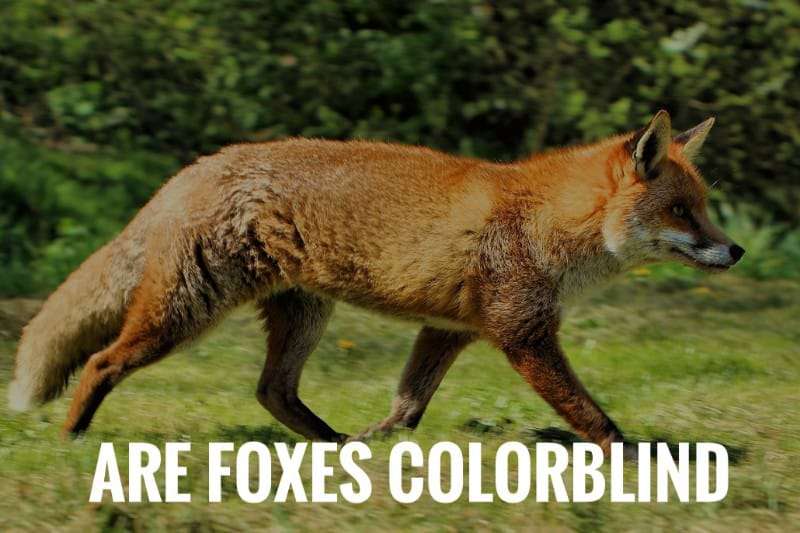Foxes are one of the most widespread animals, which have almost a worldwide distribution. From woods to meadows, mountains to deserts, rural to suburbs, they are found everywhere.
Their cunningness and intelligence have made them popular creatures in children’s bedtime stories. Foxes belong to the same family as dogs, the Canidae, and share several characteristics with them.
Several queries about foxes have been surfacing, among which the most sought after is, “Are Foxes Colorblind & How do they see the world?” To answer the question, we bring you our today’s article, “Are Foxes Colorblind & How do they see the world? All About Fox Vision.”
The answer to this question is, Yes, foxes are colorblind to colors like Green and Red. They are dichromatic and see the world in mainly two colors, Blue and Green. They see the world in mainly these two colors and shades of gray and cannot perceive any other color or their shades.
Later in this article, titled, “Are Foxes Colorblind & How do they see the world? All About Fox Vision,” we are going to describe a fox’s vision vividly. So, without further delay, let us get going with our write-up.
Are Foxes Colorblind? Foxes Color Vision Explained
Yes, Foxes are indeed colorblind. Fox’s vision helps them to perceive the world only in the base colors of Blue and Yellow. Therefore, any other colors apart from these two are invisible to them, thus making them colorblind to other colors on the visible electromagnetic spectrum, like Red and Green.
For color vision, the retina possesses certain specialized cells, known as cones. A study was done on the two fox species, namely the most occurring Red Fox and the Arctic Fox.
Their retina has a majority of Middle-Long wavelength (M/L) sensitive cones and a minority of Short (S) Wavelength sensitive cones. This goes on to prove that they have dichromatic vision.

Image Source | Absolute pets
The short wavelength sensitive cone gives them vision over Blue light and the Middle-Long wavelength sensitive one over Yellow light.
The M/L sensitive cone has a peak sensitivity of 555 nm, while the Short wavelength sensitive one has that of 430-435 nm.
Since long-wavelength sensitive cones are absent, therefore Foxes are blind to colors like Red and Green.
How do Foxes see the world?
Foxes see the world in hues of Blue and Yellow. The colors they see are more pastel than vibrant. They have remarkable night vision but a relatively poor daytime vision. They are quick to capture movements around them but might have a low-resolution vision.
Foxes most likely view the world in more pastel than bright colors. Foxes have rod cells in abundance, which gives them the ability to distinguish between the shades of grey. This feature greatly helps in night vision and in picking up movements.
Foxes find it difficult to spot stationary prey, as their vision is motion sensitive. They see the world in mainly two colors and their shades, blue and yellow.
They are red-green color blind, which implies that those colors are perceived as grey and its shades. Preys that are contrasting to the environment, making it silhouetted, appear more prominent.
Despite their wide occurrence, very little research has been conducted on foxes. Since they belong to the Dog family, a similar comparison can be drawn with the dog’s eyesight and vision.
Fox’s eyes are more motion sensing, and there have been instances of the animal passing by a quiet crouching rabbit without noticing it.
Can Foxes see in the dark? (Fox’s Night vision explained)

Foxes can see extremely well in the dark. Foxes have developed a keen sense of vision over the years of evolution.
They have an abundance of rod cells, which comes into use during their vision in dark or dim lighting conditions. The presence of a reflective layer, the tapetum lucidum, further enhances their night vision capabilities.
The retinas of foxes have rod cells in plenty. These rod cells are responsible for vision at night or for detecting motion. Abundant rod cells give them a sharp night vision. The eyes of foxes are also equipped with a reflective layer in their eyes, the tapetum lucidum.
In essence, this increases the amount of light that enters the eye, sending more light through it and improving night vision. The tapetum lucidum acts as a reflective layer that reflects the light to the inside of the eye, thus making the maximum use of the light available, especially at night.
How Far Can Foxes See?
Foxes are near-sighted creatures (myopic). They are more adept at tracing prey or objects located nearer to them in their visual range. Foxes can see a maximum up to 100-120 m or a bit more, but not farther than that.
Foxes are most likely short-sighted based on their retina’s dominance by rods and complete lack of L (Long Wavelength Sensitive) cones. The absence of the macula lutea, containing the fovea, a highly sensitive part of the retina of the eye, further renders foxes myopic.
They can see nearer objects with ease, but objects located far away appear blurry. They can see up to 100- 120 m, but there is a high probability that the objects they see from this distance might appear blurry.
How good is fox eyesight?

Foxes have a larger range of vision than humans and can see well in low light. Humans only see 180 degrees, compared to the fox’s 200 degrees.
They have exceptional short-range visual acuity and excellent night vision. Foxes are said to have the myopic vision, which means that objects farther away seem hazy while objects closer to them are seen.
The 24-hour activity needs the active support of good eyesight and vision. Foxes have good visual acuity at close range. They are adept at identifying specific forms and contrasts at a distance and are extremely sensitive to movement. Their vision is mostly centered on motion.
Foxes most likely have a pretty low-resolution visual system, which may make it difficult for them to search for small, stationary things that cannot be distinguished by scent or sound. Foxes have vertically split pupils, unlike the majority of canids.
When combined with eyelids that close horizontally, these pupils may be closed more firmly than rounder ones, giving a fox greater control over how much light enters the eye and enabling them to hunt in a range of lighting settings.
A vertically split pupil may also aid foxes in maintaining a strong focus on any small ground prey that is moving laterally along the ground.
Foxes are unable to maintain a sustained focus on stationary objects for more than a few seconds due to the absence of a macula lutea in their eyes.
Their visual field is around 260 degrees, with a blind spot just behind their head that is about 100 degrees wide and a 40-degree overlap between the fields of their right and left eyes.
In conclusion, we can state that the fox has a limited ability for color vision in addition to several modifications that enable them to hunt in almost any lighting situation.
They have a rather large field of vision but restricted binocular vision and focusing capacity. They rely more heavily on movement during the day than at night for their vision.
Foxes Respond to Various Lights
Q1. Can Foxes see the green light?
Ans. No, Foxes cannot perceive green light. Their color vision extends over blue and yellow light and is therefore red and green color blind. Any colors apart from blue and yellow are perceived as grey or shades of the two colors.
Q2. Can Foxes see Red Light?
Ans. No, Foxes cannot see the Red Light too. Foxes lack the Long Wavelength Sensitive Cone, or the L cone responsible for vision in Red Light. Since they see in the Blue-Yellow spectrum, foxes are red-green color blind. These colors are seen as grey or in shades of blue and yellow.
Q3. Can Foxes see Infrared Light?
Ans. No, Foxes cannot see infrared light. They lack the ability or the system which is necessary for the perception of Infrared Light. Firstly, they lack the L cone, which makes them devoid of long wavelength light perception like Red. Since Infrared Light lies beyond Red in the electromagnetic spectrum, Foxes cannot see it as well.
Fox Vision vs. Human Vision
| Fox Vision | Human Vision |
| 1. Foxes are dichromatic beings. | 1. Human vision is trichromatic. |
| 2. They have an abundance of Rod cells and 2 cone cells (M and S). | 2. They have only one rod cell and 3 cone cells (S, M, and L). |
| 3. Can perceive only Blue and Yellow light, and are red-green color blind. | 3. Can perceive all colors of the visible spectrum. |
| 4. They possess a tapetum lucidum. | 4. Humans do not have a tapetum lucidum. |
| 5. Their visual field is around 200 degrees. | 6. Humans have a visual field of 180 degrees. |
Here, we conclude our article on “Are Foxes Colorblind & How do they see the world? All About Fox Vision.” We cover a diverse list of topics from the environment around us, so keep a close eye so that you don’t miss any article. Goodbye until then.
Also Read:

Meet Abhidept (nickname Monty), the visionary founder of How It See, being an engineering student, he’s fueled by an insatiable curiosity about the world around him. He is captivated by an eclectic correlation between animal groups, science, and nature, and this fascination drives his quest for understanding.
After completing his degree, he’s set on a mission to delve deep into the realm of nature, accumulating knowledge to share with you through his writing. In the meantime, he loves to watch anime and read anime.

Comments are closed.